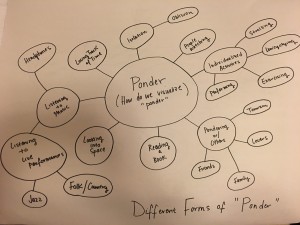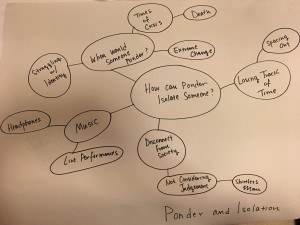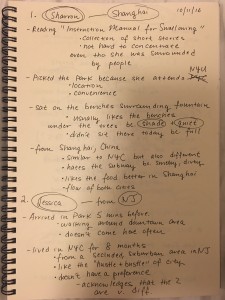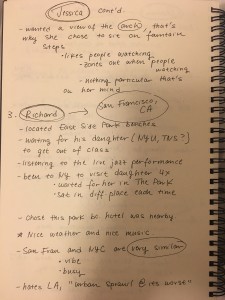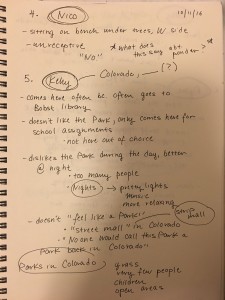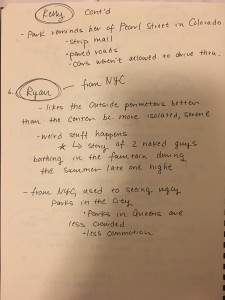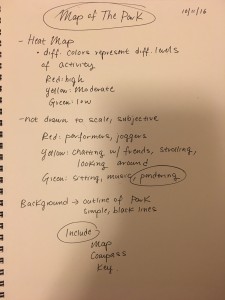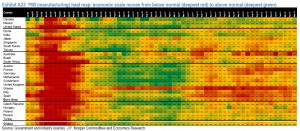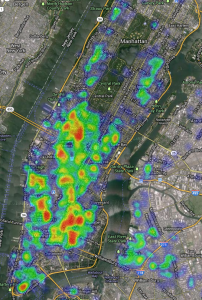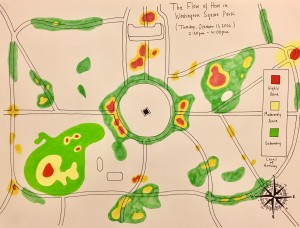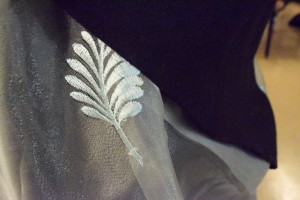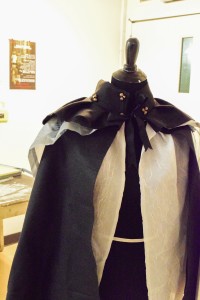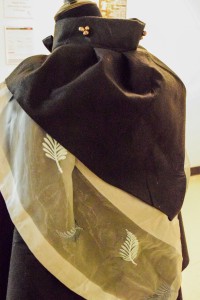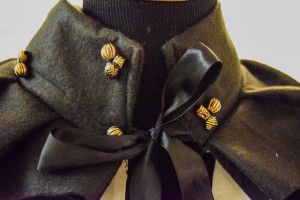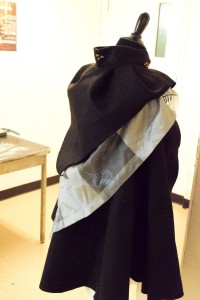Concept maps.
Interview Questions
- Why did you decide to come to Washington Square Park today?
- Do you know anything historical about the park/ Have you been coming to this park for a long time?
- How has the park changed in your time coming here?
- What does this park mean to you/ How do you use this park?
- Do you have a memorable moment here?
- What were you thinking about before we approached you?
- What are you feelings about the park?
- Do you have a favorite/least favorite location in the park?
Interviews conducted at Washington Square Park.
Sources of inspiration for the final map.
Completed map.
Completed garment.
Imagined Places (Voices of Others)
Sharron, patiently awaiting her next class at NYU, sits on a park bench near the fountain. She is reading “Instruction Manual for Swallowing”, a collection of short stories. Even though she is surrounded by people, she does not find it hard to concentrate. She is already accustomed to the hustle and bustle of the city; back home in Shanghai, she would often situate herself in busy places like Washington Square Park to read and do work.
Richard, a middle aged man from San Francisco, California, sits on a bench diagonally from a musical jazz duo. He seems to be at peace, enjoying the good music and the warm sunshine. He chose this park out of convenience. He is waiting for his daughter, who goes to college in New York, to get out of class. He’s been here for times already. He doesn’t think that New York and San Francisco are all that different. Like Sharron, he, too, is accustomed to the vibe of this city because it reminds him so much of his home.
Jessica, a young woman in her early twenties, sits on the steps inside the fountain. She is from a small suburban town in New Jersey and moved to the city just eight months ago. Her eyes wander, picking and choosing something to concentrate on. About ten feet to her left, a balding man rides a unicycle while holding a dozen helium balloons. Her mind is blank and she is simply enjoying what’s in front of her at the moment. She doesn’t like the city better than her hometown or vice versa. There are pros and cons to both places and she is able to acknowledge and appreciate both their similarities and their differences.
Forgotten Places
Washington Square Park is located in the Greenwich Village neighborhood of Lower Manhattan, New York City. The Park is an open space with a tradition of celebrating nonconformity. Many of the buildings surrounding the park at one time served as homes and studios for artists. The two prominent features are the Washington Square Arch and a large fountain. People commemorated by statues and monuments include George Washington, Giuseppe Garibaldi and Alexander Lyman Holley.
The land was once divided by a narrow marshy valley through which Minetta Creek ran. In the early 17th century, a Native American Village known as Sapokanican or “Tobacco Field” was nearby. By the mid 17th century, the land on each side of the creek was used as farmland by the Dutch. The Dutch then gave the land to slaves, thus freeing them. The slaves were told that, even though they were no longer slaves, they had to give a portion of the profits they received from the land to the Dutch West India Company. Also, their children would be born as slaves.
In April of 1797, the Common Council of New York purchased the fields to the east of the Minetta for a public burial ground. It was used for burying unknown people when they died. Most of those who died during the yellow fever epidemic of the 19th century were also buried in the Park as a hygienic measure. A lot of these bodies are still under the ground today. Creating a cool duality to the celebratory vibe that is average for the park now.
In 1826, the City bought the land west of the Creek and turned it into the Washington Military Parade Ground. Volunteer militia companies responsible for the nation’s defense would train in the Park.
In 1889, in celebration of the centennial of George Washington’s inauguration as president, a large Memorial Arch was erected north of the Park. The temporary arch was so popular that a permanent marble arch was erected in 1892. The arch was modeled after the Arc de Triomphe in Paris.
Also west of the square is the Triangle Shirtwaist factory, a build where real tragedy took place. Women died in a terrible fire due to their terrible working conditions. This event shaped the future for every working american, and sparked the workers rights movement to create laws about working conditions. Women as young as 14 died in the fire. The women had to choose to either burn to death or jump and kill themselves, many of them choose the later, because falling hurt less than burning to death.
